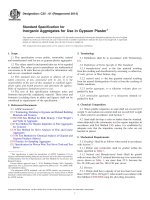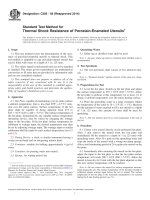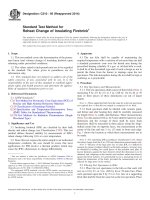Astm c 484 99 (2014)
Bạn đang xem bản rút gọn của tài liệu. Xem và tải ngay bản đầy đủ của tài liệu tại đây (64.6 KB, 2 trang )
Designation: C484 − 99 (Reapproved 2014)
Standard Test Method for
Thermal Shock Resistance of Glazed Ceramic Tile1
This standard is issued under the fixed designation C484; the number immediately following the designation indicates the year of
original adoption or, in the case of revision, the year of last revision. A number in parentheses indicates the year of last reapproval. A
superscript epsilon (´) indicates an editorial change since the last revision or reapproval.
greater than 10 %, respectively. After completing ten cycles,
the tiles are inspected for any damage as a result of the cycling.
1. Scope
1.1 This test method covers the determination of the resistance to thermal shock of glazed ceramic tiles under normal
conditions of use.
5. Significance and Use
5.1 This test method is intended for testing glazed ceramic
tile that are to be used in areas in which they may be subjected
to rapid or severe temperature changes.
1.2 The values stated in SI units are to be regarded as the
standard. The values given in parentheses are for information
only.
1.3 This standard does not purport to address all of the
safety concerns, if any, associated with its use. It is the
responsibility of the user of this standard to establish appropriate safety and health practices and determine the applicability of regulatory limitations prior to use.
6. Apparatus
6.1 Water Bath, for testing with immersion, through which
15 6 5°C (59 6 9°F) water flows at a rate of 1 gal/min. The
bath shall hold at least 5 gal (19 L) of water and shall be of
dimensions such that five whole tiles are immersed completely
when placed in the bath vertically.
2. Referenced Documents
6.2 Covered Water Bath, for testing without immersion,
consisting of the Water Bath in 6.1 covered with an aluminum
sheet and layer of aluminum grains. The aluminum sheet shall
be 5.18–mm (0.204–in.) thick—No. 4 B&S—gage and of
dimensions such that five whole tiles can be placed glazed face
down on it. The aluminum sheet shall cover the mouth of the
bath with the flow of water directed such that it is in contact
with bottom surface of the aluminum sheet. The entire top
surface of the aluminum sheet shall be covered with a 3–mm
(0.197–in.) thick layer of aluminum grains. The diameters of
the aluminum grains shall be in the range of 0.3 mm (0.012 in.)
to 0.6 mm (0.024 in.).
2.1 ASTM Standards:2
C242 Terminology of Ceramic Whitewares and Related
Products
C373 Test Method for Water Absorption, Bulk Density,
Apparent Porosity, and Apparent Specific Gravity of Fired
Whiteware Products, Ceramic Tiles, and Glass Tiles
3. Terminology
3.1 Definitions—For the definitions of terms used on this
test method, refer to Terminology C242.
4. Summary of Test Method
6.3 Oven, capable of maintaining a constant temperature of
145 6 5°C (293 6 9°F).
4.1 This test method consists of determining the thermal
shock resistance of ceramic tiles by cycling a sample ten times
between the temperatures of 15 6 5°C (59 6 9°F) and 145 6
5°C (293 6 9°F). This test method includes two procedures,
with and without immersion, for tiles with a water absorption
less than or equal to 10 % and tiles with a water absorption
7. Sampling
7.1 The test sample shall consist of five whole tiles or trim
units, selected at random from the lot to be tested.
8. Procedure
8.1 Before testing for resistance to thermal shock, inspect
the tiles for visible defects. To assist in detecting defects, a
suitable stain, such as waterproof black India ink or a 1 %
aqueous solution of methylene blue, may be used. Apply the
ink or dye solution to the face of the tiles and wipe off with a
damp cloth after 1 min. All tiles should be free from defects
before testing.
1
This test method is under the jurisdiction of ASTM Committee C21 on Ceramic
Whitewares and Related Productsand is the direct responsibility of Subcommittee
C21.06 on Ceramic Tile.
Current edition approved Dec. 1, 2014. Published December 2014. Originally
approved in 1961. Last previous edition approved in 2009 as C484 – 99 (2009).
DOI: 10.1520/C0484-99R14.
2
For referenced ASTM standards, visit the ASTM website, www.astm.org, or
contact ASTM Customer Service at For Annual Book of ASTM
Standards volume information, refer to the standard’s Document Summary page on
the ASTM website.
8.2 Testing With Immersion—For tiles with a water absorption less than or equal to 10 %, the low temperature condition
Copyright © ASTM International, 100 Barr Harbor Drive, PO Box C700, West Conshohocken, PA 19428-2959. United States
1
C484 − 99 (2014)
shall consist of immersing the tiles vertically in the water bath,
such that they are not in contact with each other, for 5 min.
9. Report
9.1 The test report shall include the following information:
9.1.1 A description of the tiles,
9.1.2 The water absorption (%) of the tiles,
9.1.3 The type of test performed (with or without
immersion), and
9.1.4 The number of test specimens with visible defects.
8.3 Testing Without Immersion—For tiles with a water
absorption greater than 10 %, the low temperature condition
shall consist of placing the tiles glazed face down on the
covered water bath, such that they are not in contact with each
other, for 5 min.
8.4 Testing With and Without Immersion—After 5 min at the
low temperature condition, immediately transfer the tiles to the
oven maintained at a temperature of 145 6 5°C (293 6 9°F).
Continue to heat the tiles in the oven until a uniform temperature is achieved (usually 20 min) and then immediately transfer
the tiles back to the low temperature condition.
10. Precision and Bias
10.1 No justifiable statements can be made either on the
precision or on the bias of this test method for testing thermal
shock resistance of glazed ceramic tile by this test method
since the test result merely states whether there is conformance
to the criteria for success specified in the procedure.
8.5 Repeat this cycle ten times.
8.6 After completing ten cycles, inspect the tiles for visible
defects. To assist in detecting defects, a suitable stain such as
waterproof black India ink or a 1 % aqueous solution of
methylene blue, may be used. Apply the ink or dye solution to
the face of the tiles and wipe off with a damp cloth after 1 min.
11. Keywords
11.1 ceramic tile; glazed ceramic tile; thermal shock resistance
ASTM International takes no position respecting the validity of any patent rights asserted in connection with any item mentioned
in this standard. Users of this standard are expressly advised that determination of the validity of any such patent rights, and the risk
of infringement of such rights, are entirely their own responsibility.
This standard is subject to revision at any time by the responsible technical committee and must be reviewed every five years and
if not revised, either reapproved or withdrawn. Your comments are invited either for revision of this standard or for additional standards
and should be addressed to ASTM International Headquarters. Your comments will receive careful consideration at a meeting of the
responsible technical committee, which you may attend. If you feel that your comments have not received a fair hearing you should
make your views known to the ASTM Committee on Standards, at the address shown below.
This standard is copyrighted by ASTM International, 100 Barr Harbor Drive, PO Box C700, West Conshohocken, PA 19428-2959,
United States. Individual reprints (single or multiple copies) of this standard may be obtained by contacting ASTM at the above
address or at 610-832-9585 (phone), 610-832-9555 (fax), or (e-mail); or through the ASTM website
(www.astm.org). Permission rights to photocopy the standard may also be secured from the Copyright Clearance Center, 222
Rosewood Drive, Danvers, MA 01923, Tel: (978) 646-2600; />
2









